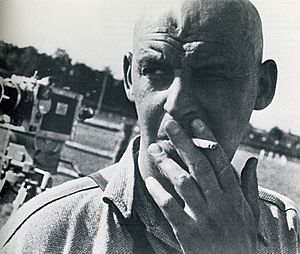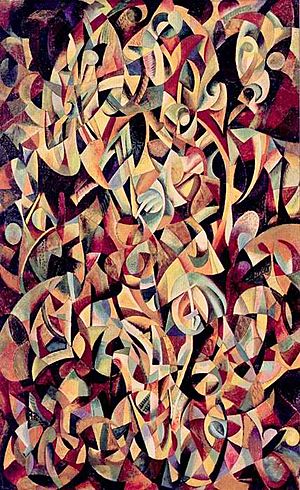Alexander Rodchenko facts for kids
Quick facts for kids
Alexander Rodchenko
|
|
|---|---|

Rodchenko in 1935
|
|
| Born |
Aleksander Mikhailovich Rodchenko
5 December 1891 |
| Died | 3 December 1956 (aged 64) |
| Known for | Painting, photography |
| Movement | Constructivism |
Aleksander Mikhailovich Rodchenko (Russian: Алекса́ндр Миха́йлович Ро́дченко; 5 December 1891 – 3 December 1956) was a famous Russian and Soviet artist. He was a talented sculptor, photographer, and graphic designer.
Rodchenko was one of the main people who started Constructivism and Russian design. He was married to the artist Varvara Stepanova. He was a very creative artist after the Russian Revolution. He started as a painter and graphic designer. Later, he became very interested in photomontage and photography.
His photos often showed social issues. He liked to take pictures from unusual angles, like from high above or low down. This was to make people look at things in a new way. He believed you should take many different photos of something. This helps you see it from all sides, not just one view.
Contents
Who Was Alexander Rodchenko?
Alexander Rodchenko was a key figure in modern art. He helped shape how art was made in Russia. He was always trying new ways to create. His work changed how people saw art and design.
Early Life and Art Training
Rodchenko was born in St. Petersburg in 1891. His family was working-class. After his father died in 1909, they moved to Kazan. He became an artist even though he had not been around much art before. He learned a lot from art magazines.
In 1910, Rodchenko began studying art in Kazan. There he met Varvara Stepanova, who later became his wife. After 1914, he continued his art training in Moscow. He started making abstract drawings in 1915. These were influenced by Suprematism, an art style using simple shapes.
Exploring New Art Styles
Rodchenko's art was influenced by Cubism and Futurism. These styles broke things into geometric shapes. He also liked the simple shapes of Suprematism. He worked with Vladimir Tatlin, another important artist. Rodchenko stopped drawing people. Instead, he used tools like a compass and ruler for his paintings. He wanted to remove any personal brushstrokes.
In 1920, the government put Rodchenko in charge of art schools and museums. He also taught at a special art school called VKhUTEMAS. This school was similar to the Bauhaus in Germany.
In 1921, he joined the Productivist group. This group believed art should be part of everyday life. Rodchenko stopped painting. He focused on designing posters, books, and films. He worked closely with the filmmaker Dziga Vertov.
Rodchenko was impressed by German artists who made photomontage. This is art made by cutting and gluing different photos together. He started making his own photomontages in 1923. He used his own photos from 1924 onwards. His first published photomontage was for a poem by Vladimir Mayakovsky.
One of his most famous posters was for a publishing house in 1924. It showed a young woman shouting about "Books in all branches of knowledge." From 1923 to 1928, Rodchenko worked with Mayakovsky. They designed magazines for Constructivist artists. Many of Rodchenko's photos were used in these magazines. His pictures often had strong diagonal lines. They focused on how objects looked in space.
Art and the Soviet Government
In the 1920s, Rodchenko's art was very abstract. However, the Soviet Union started to change. The government wanted art to be more realistic. They wanted art to show the ideals of Socialist realism. This meant art should be easy to understand and show positive images of Soviet life.
Rodchenko's abstract work faced criticism. Some critics said his art was too focused on style, not on meaning. They wanted art to serve the government's goals. In 1935, Rodchenko had to publicly say that his earlier abstract works were wrong. He promised to make art that supported Socialist Realism.
Even with this pressure, Rodchenko still made unique art. In 1934, he took one of his most famous photos, Girl with Leica. This photo still showed his special style.
Later Years and Legacy
Rodchenko returned to painting in the late 1930s. He stopped taking photos in 1942. In the 1940s, he made abstract paintings again. He also helped organize photo exhibitions for the government. He passed away in Moscow in 1956.
Rodchenko's Impact on Art
Rodchenko's work had a huge impact on art and design. Many graphic designers today use ideas that Rodchenko first explored. His influence can be seen everywhere. For example, American artist Barbara Kruger was inspired by his work.
His famous photo of Lilya Brik has inspired many music album covers. Bands like The Ex and Franz Ferdinand have used it.
What Was "The End of Painting"?
In 1921, Rodchenko created very simple paintings. They were just one color, like red, blue, or yellow. He showed them in an exhibition in Moscow. For artists of the Russian Revolution, this was a big step. Rodchenko believed this was the "end of easel painting." He felt it was the end of old art rules. He said, "I reduced painting to its logical conclusion... it's all over." This meant he wanted to move art in a completely new direction.
Books About Rodchenko
- Alexander Rodchenko. Edited by National Center of Cinematography and the moving image. New York: Pantheon, 1987. ISBN: 978-0-394756-24-0
- Rodchenko – Photography – 1924 ‐ 1954. Edited by Alexander Lavrentiev. UK: Könemann, 1995. ISBN: 978-3-895081-10-1
- Rodchenko. Edited by Peter MacGill. Göttingen, Germany: Steidl, 2012. ISBN: 978-3-869302-45-4
See Also
 In Spanish: Aleksandr Ródchenko para niños
In Spanish: Aleksandr Ródchenko para niños
- Anti-art
- List of Russian artists
- Russian avant-garde


